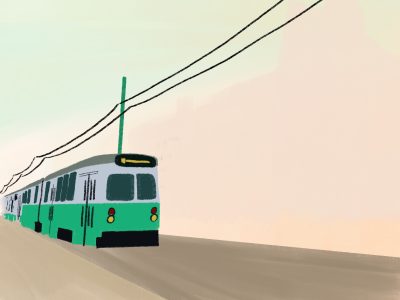On the long expanse of Commonwealth Avenue lies our beloved Boston University. BU is known for being integrated within the heart of Boston — the city is our campus.
However, this also means we have to constantly make the trek up and down Commonwealth Avenue, from Bay State to the George Sherman Union to Allston.
If students don’t have the time to walk 15 minutes, they often hop on the handy Massachusetts Bay Transportation Authority Green Line B Branch, which runs straight through the center of campus.
Starting Monday, four of these T stops in West Campus are being consolidated into two new and improved ones.

Though it doesn’t seem to be a pressing issue, it does make sense. The four stations in question — BU West, Saint Paul Street, Pleasant Street and Babcock Street — are all very close together. For the sake of convenience, reducing the number of stations could increase efficiency and make for a less stop-and-start ride.
The project includes raised platforms for accessible boarding, longer stations with more benches and shelter and improved traffic and pedestrian safety.
While improving accessibility is needed, it is interesting the focus of this project lies on streamlining a small section of the branch. BU is already a hub of construction, constantly plagued by one project or another. Students, commuters and residents are all impacted — or at least inconvenienced — by this never-ending parade.
Look no further than the recent College of Fine Arts remodeling and the current construction of the Center for Computing and Data Sciences building. The MBTA project is set to finish in early 2022, which means there will be a year or more of construction and impacted traffic.
The $29 million renovation also comes as a part of the $8 billion Green Line Transformation project.
But there are broader and more impactful issues to be addressed, such as expanding the CharlieCard program so cards are more accessible, especially on BU’s campus. Or, even shifting to a virtual card system with less plastic waste, making cards easier to reload, more convenient and COVID-19 safe.
The MBTA — and BU’s forms of transportation as well — should also work to improve rider accessibility for those who have a disability or may not be able to use these services as easily as others.
There’s also the issue of the $2.40 fare. A separate effort to implement a new fare collection system and ensure riders pay is being considered for future projects. This comes at the heels of a larger conversation about how some riders are unable to pay to ride and why fares can’t be reduced or abolished entirely.
Boston City Councilor Michelle Wu, a candidate in the 2021 Boston mayoral campaign, is basing her platform on free public transportation, among other issues. It’s clear transportation and economic justice will play a major role in the upcoming race, and depending on the results, the MBTA may not need this project after all.
Since the fare collection system is still a ways away and its fate yet to be determined, what students and residents on Commonwealth Avenue have to worry about now is the shuttle system that will replace the train as the stations are being consolidated.
The good news is BU students have a plethora of transportation options at their disposal. When the buses or trolleys give you a hard time, you can jump on a BU Shuttle.
The buses and the Terrier Transit app may be unreliable, but many students prefer traveling via bus, especially because it reaches Newbury Street and stops at nearly every large dorm. Plus, it’s a completely free service for tuition-paying riders.
Of course, improvements could be made. The shuttles are sporadic, and many times, the actual wait is longer than the advertised 10 minutes. And although the service is meant for students and the website says that identification is checked, having a BU ID doesn’t appear to be required to board. Additionally, students have not been required to present a green compliance badge while stepping on the bus.
But, let’s say the BUS app is malfunctioning or you’ve waited 15 minutes for a shuttle that won’t appear anytime soon: You can take the 57 bus that travels right on Commonwealth Avenue.
Alternatively, if you’re into more green versions of transportation, you could learn to skateboard or — perhaps a more practical idea — rent a Bluebike. The Charles River Campus has six Bluebikes stations, and BU students and faculty can get a discounted membership.
Commonwealth Avenue also got new cycle tracks built for bicycling safety. And our campus is dotted with bike racks and other bike paths. You can even register your bike with BU’s Parking and Transportation Services to gain access to restricted parking spaces, among other perks.
We’re lucky to have such a variety of transportation options available to us. Despite our campus being so long, it is quite accessible, and the University has ensured students’ safety and convenience.
And though the MBTA must address issues that disproportionately put certain residents and communities at a disadvantage, its plans to consolidate West Campus stations can at least improve BU transportation and bridge the ability gap.
It is increasingly important to have these options on campus now — during the pandemic and the winter — with students cooped up in their rooms with no other incentive to venture outside.

















































































































